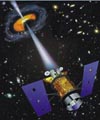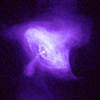News Archive
1996 |
1997 |
1998 |
1999 |
2000 |
2001 |
2002 |
2003
2004 | 2005 | 2006 | 2007 | 2008 | 2009 | 2010 | 2011
2012 | 2013 | 2014 | 2015
2004 | 2005 | 2006 | 2007 | 2008 | 2009 | 2010 | 2011
2012 | 2013 | 2014 | 2015
![]()
Welcome to our archive of past news articles.
You will find previous articles listed below
from most the recent back to our first articles in 1996.
1999
 |
The Universe Lights Up on Beethoven's Birthday [30 December 1999] - Ludwig van Beethoven would have been impressed. On December 16, the 229th anniversary of the musician's birth, the Universe lit up in gamma rays that, for a few seconds, outshone the entire sky. |
 |
European Space Agency Launches XMM [10 December 1999] - In July 1999, NASA launched an extraordinary X-ray telescope named Chandra. At a distance one-third of the way to the moon, the telescope's deep, lonely orbit gives it an unimpeded view of distant exploding stars and clusters of galaxies. Now Chandra has company, a European satellite called XMM that is every bit as impressive. |
 |
SWIFT Satellite to Catch the Most Powerful Flashes of Light Known in the Universe [26 October 1999] - Once or twice a day, without warning, there are brief flashes of highly energetic light that momentarily outshine the rest of the universe. NASA has chosen to develop a mission that will be capable of capturing information about these unpredictable bursts of gamma-rays. |
 |
Discovery of Small X-ray Ring around Crab Pulsar Solves Old Mystery [15 October 1999] - Recent images obtained with the Chandra X-ray Observatory have uncovered part of the secrets of the Crab Nebula by revealing a bright small ring around its center. Scientists had long searched for the missing link between the central pulsar and the nebula and it would seem that their quest is now over. |
 |
Astronomers Find First Direct Evidence Linking Black Holes and Supernovae [21 September 1999] - Astronomers believe that black holes are the evolutionary endpoints of stars at least 10 to 15 times as massive as the Sun. If such a star undergoes a violent supernova explosion, the core of the star it leaves behind may gravitationally collapse in on itself, creating a singularity - an entity with zero volume and infinite density - a black hole. |
 |
Chandra Observatory Launch Lights Up the Night Sky [23 July 1999] - X-ray astronomy moved into the 21st century today with the launch of the Chandra X-ray Observatory (CXO). Shortly before 12:30 a.m. EDT, the Space Shuttle Columbia blasted off from the Kennedy Space Center in Florida. Under the command of Lt. Colonel Eileen Collins, the shuttle will begin to deploy CXO later today in their 5 day mission. |
 |
Brighter than an Exploding Star, It's a Hypernova! [20 May 1999] - In a galaxy not so far away - only 25 million light-years - astronomers have found what looks like are the remnants of strange celestial explosions called hypernovae. "Hypernovae are possibly the most powerful explosions in our Universe since the Big Bang," said Q. Daniel Wang, an astrophysicist at Northwestern University. Such explosions are more powerful than supernovae, the spectacular death gasps of stars some 5-10 times more massive than our Sun. In fact, hypernovae may produce some 100 times more energy than supernovae. But what are these explosions and what causes them? Astronomers are not sure at this point. It is hoped that the discovery of these two suspected hypernova remnants, called MF83 and NGC5471B, located in the nearby spiral galaxy M101 will allow astrophysicists to infer their true nature. |
 |
STS-93 Readies for Lift-Off with Chandra Observatory [28 January 1999] - The next Shuttle flight will occur sometime in the Spring of 1999, and carry in its payload bay NASA's next X-ray astronomy satellite. The exact date for launch is not yet determined due to a recent delay, but it will occur no earlier than April 8. This flight will also be the first time a woman astronaut, US Air Force Colonel Eileen Collins, will serve as the Flight Commander. STS-93 will be the 94th Space Shuttle flight, and the 26th flight for the orbiter Columbia. |
1996 |
1997 |
1998 |
1999 |
2000 |
2001 |
2002 |
2003
2004 | 2005 | 2006 | 2007 | 2008 | 2009 | 2010 | 2011
2012 | 2013 | 2014 | 2015
2004 | 2005 | 2006 | 2007 | 2008 | 2009 | 2010 | 2011
2012 | 2013 | 2014 | 2015
Take Me to the News Page

